Group helped community mark the centenary of the Great War
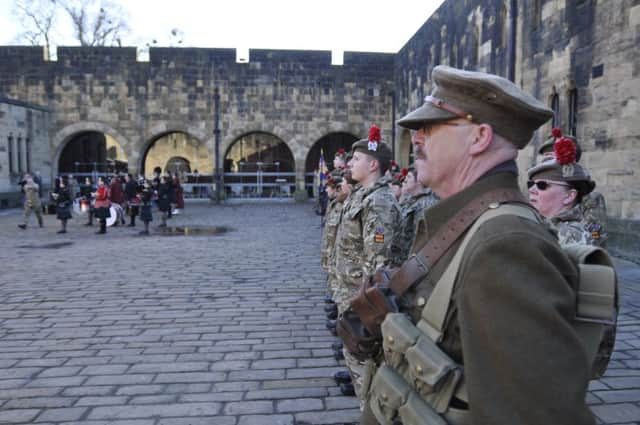

Commemorating the March of the Northumberland Fusiliers 20th (Service) Battalion (1st Tyneside Scottish)
On January 29, 1915, the volunteer soldiers who’d answered Kitchener’s call and flocked to join the Tyneside Scottish (Service) Battalions of the Northumberland Fusiliers began their journey away from home and hearth and the familiar streets of Newcastle, a journey which would in time see them engaged on the Western Front and their tragic role on the first day of the Battles of the Somme.
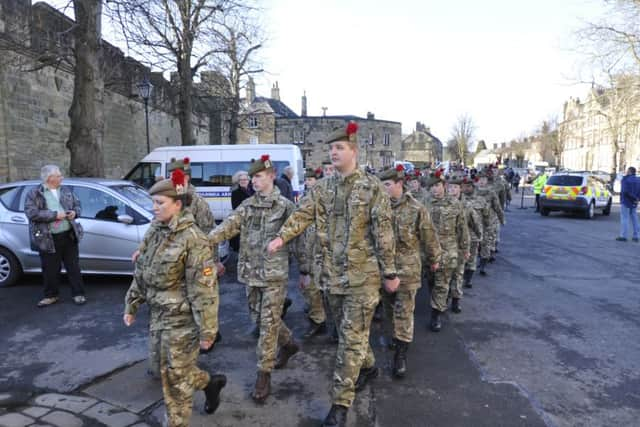

Advertisement
Hide AdAdvertisement
Hide AdThe 1st Tyneside Scottish paraded in Newcastle and, after a civic send-off, began a march to Alnwick to begin their training.
A day of marching in winter weather took the men to Morpeth, where, after an overnight stay, they marched on January 30 through Felton to Alnwick to take up occupation of Alnwick Camp where they began Brigade-level training in preparation for the fighting ahead.
The group wanted to commemorate the centenary of this event which is remembered in the North East to this day and lay at the very heart of the project.
So, its signature 2015 events began on Saturday, January 31, 2015, with a Commemorative Service at St Thomas the Martyr Church, Barras Bridge, Newcastle.
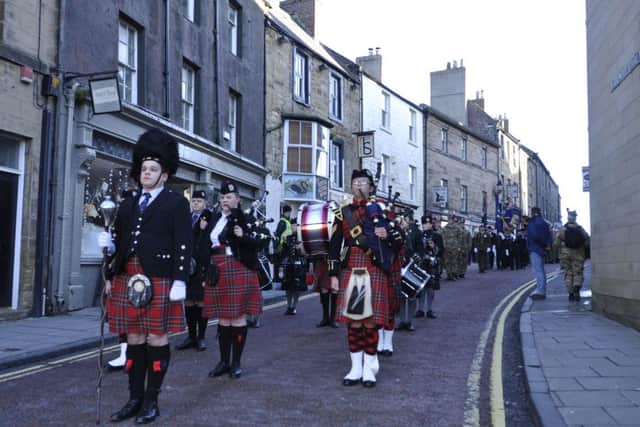

Advertisement
Hide AdAdvertisement
Hide AdA moving service was well attended by almost 200 people including the Lord Mayor of Newcastle, serving officers and regimental representatives of the Royal Artillery and the Fifth Fusiliers, members of the Northumberland Army Cadet force, the Royal British Legion (RBL), Western Front Association (WFA), Tyneside Scottish Association (TSA), various other veterans associations, family relatives of men who had marched 100 years ago and interested members of the public.
A contemporary feel to the event was brought by uniformed re-enactors of both the Durham Pals and Tyneside Time Bandits.
The standards of the RBL were paraded and the pipes and drums of the Army Cadet Force band ably accompanied proceedings in appropriate style.
Outside the church, a short wreath-laying ceremony was held at the well-known The Response statue, which commemorates the Kitchener volunteers of 1914.
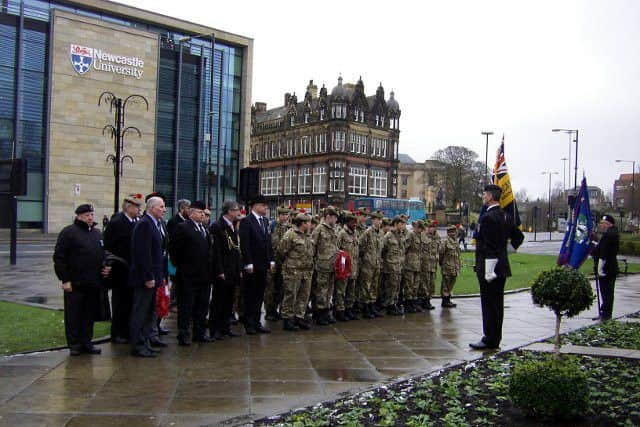

Advertisement
Hide AdAdvertisement
Hide AdActivities moved to Felton, which was on the route of the march and has well-documented accounts of the happenings 100 years ago.
At a packed village hall, more than 125 people braved a stormy winter’s evening, on January 31, to attend an event designed to give historical context to the weekend.
John Sheen, well-known as a published military historian on the history of the Tyneside Scottish Brigade and other local regiments, gave a moving and informative talk about the history of the Brigade.
This was followed by a presentation from the TSA given by Major Ian Jones (RTD) which joined up the history of 100 years ago to the living regiment today. The TSA put on an excellent display of historical material.
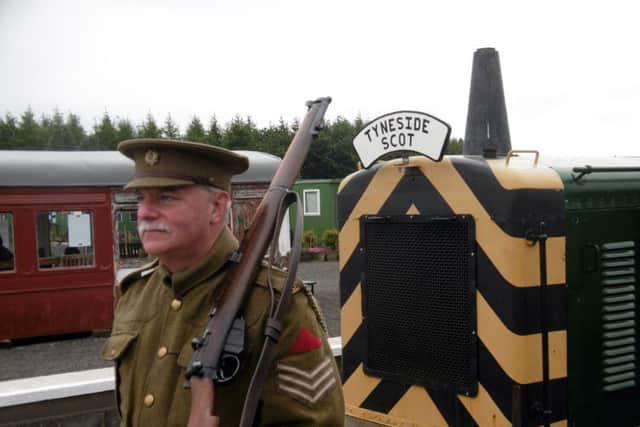

Advertisement
Hide AdAdvertisement
Hide AdJohn Sadler and Rob Horne, of Tyneside Time Bandits, were on hand to show people the uniforms and equipment of the First World War, some music of the period was performed and even the odd cake was eaten.
Dave Barras, the group’s 2015 events project manager, said: “Thankfully, the overnight snow had mostly gone when the morning of Sunday, February 1, 2015, dawned bright and cold.
“When the idea of commemorating the march was first suggested by our much-missed late WFA branch secretary David Easton, it was always the intention to recreate the entry of the Tyneside Scottish into Alnwick, and we achieved this again 100 years on.”
Another 200 people, including representatives from the Army, Army Cadet Force, local political dignitaries, HLF, WFA, RBL, TSA, other veterans’ associations, relatives of the men of the Tyneside Scottish of 1914, re-enactors in 1914 uniforms, Scouts and many others marched behind a military band of pipes and drums supplied by the Army for the last mile of the route into Alnwick, and into the castle where the parade was dismissed in the Castle Yard.
Advertisement
Hide AdAdvertisement
Hide AdHundreds of people lined the street to watch a splendid and colourful spectacle, which was a very enjoyable and fitting way of remembering the men who marched into Alnwick all those years before.
At the castle, participants from the march, together with a number of more elderly invited guests – up to 250 in total – were welcomed by the Duke of Northumberland at an official reception in the Guest Hall and refreshments were served by volunteers from the Fusiliers’ Museum in period costumes.


Mr Barras added: “Although it was a tiring weekend for the small committee which organised these events, we were delighted that all four were so successful and well-received, as evidenced by some excellent coverage by regional and local press.”
Commemorating the Tyneside Scottish Brigade at Alnwick
To remember the training of those troops 100 years ago, the group was pleased to work in partnership with the Fusiliers Museum and contribute to a First World War-themed day held at Alnwick Castle on Sunday, July 26.
Advertisement
Hide AdAdvertisement
Hide AdA local re-enactment group was commissioned to support activities on the day in period uniform and, with displays of First World War equipment and an information point, was available to deal with inquiries from the 2,500 or more visitors to the castle.
Commemorating the Brigade’s departure from Alnwick
The Kitchener volunteers of the Tyneside Scottish battalions left Alnwick by train in August 1915, as they began a journey which took them to further training on Salisbury Plain before they went to the Western Front and their involvement in the Battles of the Somme.
The Tyneside Scottish Brigade, comprising the 20th, 21st, 22nd and 23rd (Service) Battalions of the Northumberland Fusiliers, suffered 2,438 casualties on July 1, 1916, among the highest for any brigade in the attacks on that fateful day.
As the group marked the centenary of the day the Brigade left our community, it sponsored part of the musical programme of the Alnwick International Music Festival.
Advertisement
Hide AdAdvertisement
Hide AdMr Barras said: “By doing this, we hope to give an opportunity to remember the events of 100 years ago to the day, and for those who participate to both enjoy the music and spare a thought for those who marched away to war, and those they left behind.”
Additionally, they worked in partnership with Aln Valley Railway Society and arranged for their services that weekend to run with the Tyneside Scot name-board on the locomotive, in memory of the troop trains leaving Alnwick 100 years ago.
An information display explaining the history of the Tyneside Scottish Brigade, its formation, training and participation in the Battles of the Somme was on display at Lionheart Station, home of the society.
Fascinating insight on armed camp DVD
Few people are still alive who have any knowledge of the large camp and training grounds on the Pastures opposite Alnwick Castle and nearby or of the impact the army had on Alnwick town and surrounding districts during the First World War.
Advertisement
Hide AdAdvertisement
Hide AdNeil Brison, DVD project manager, told the Gazette: “We have been privileged to be able to capture the recollections of local historian Cliff Pettit, a retired solicitor, who has recounted the story and history of Alnwick Camp, illustrated with his unique collection of photographs, postcards and other memorabilia.”
The camp was built at the end of 1914 to accommodate battalions of the Northumberland Fusiliers undergoing training in readiness for service in France and Flanders.
Initially completed to the specific design of the War Office to provide 39 huts each sleeping 26 men (ie, to house a single battalion), it was later quadrupled in size to accommodate a full infantry brigade – the four camps were identified A, B, C, and D.
After the Tyneside Scottish Brigade left Alnwick in August 1915, the camp was converted to become a convalescent hospital, later it was used by the Northern Cyclist Battalion and it became a major base for the Machine Gun Corps and Northern Command.
Advertisement
Hide AdAdvertisement
Hide AdAs any reader who has been involved with a project such as this will probably empathise with, it has taken far longer to complete filming, editing, splicing, adding music, etc, than planned, however, distribution of the DVD is now underway to the national WFA, which sponsored it; partner organisations; participating schools; local councils; local history groups; local and regional press; and to other organisations with which the group engaged.
Legacy
Interviewed before the group’s final meeting to mark effective completion of the project, chairman Derek Gladding expressed the group’s hopes as to what has been achieved.
He said: “By bringing together 1915 and 2015 through rewarding and enjoyable events, exhibitions and activities, hopefully the group has generated greater awareness and a better understanding of the joint effort involved 100 years ago and the impact of the First World War on the people and communities of the wider Alnwick district.
“For the 580 pupils and students directly involved with the project, hopefully their understanding of the issues faced by people was heightened in a highly visual and entertaining way. We’ll be leaving resources for schools, community groups, and a world-wide audience through the teaching portal, search database, the Alnwick 1915 – An Armed Camp DVD, and Heritage Trail leaflet. Aspects of First World War heritage have been recorded for the first time.”
2016 and beyond
Advertisement
Hide AdAdvertisement
Hide AdClearly the project has been enjoyable for all, but it’s also been demanding in terms of time and effort needed by a relatively small team of volunteers to deliver an ambitious programme during the last 18 months or so.
When asked about plans for commemorating the remaining centenary years of the conflict, chairman Derek Gladding said: “The Alnwick District WW1 Centenary Commemoration Group has completed its task and there are no plans for it to continue in any form to commemorate later centenary war years.
“Northumberland WFA Branch may initiate some future commemoration activities in the area, but on a much-reduced scale.
“Of course, the branch will continue to maintain the search database and would love to hear from anyone able to contribute more information on, or photographs of men who were killed or died in the service of their country during the First World War. Anyone interested should contact the branch at [email protected]“Hopefully, schools will also continue to use and benefit from the teaching resources portal available via the website – www.bailiffgatemuseum.co.uk/ww1”